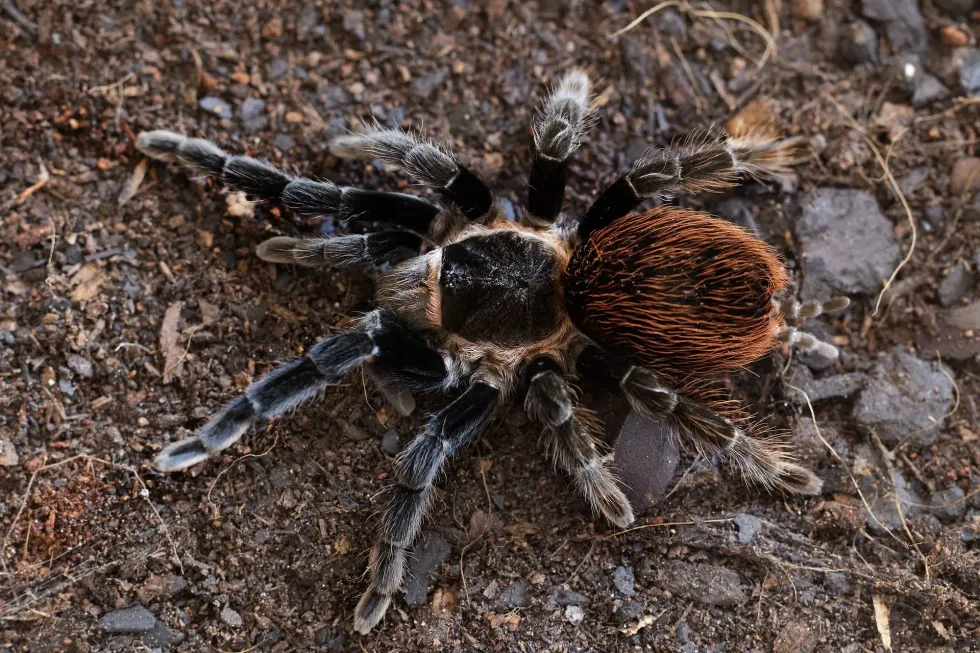The Mexican red rump tarantula (former scientific name Brachypelma vagans) is a Central American species of tarantula that can be found in humid, semi-arid locations. It is mostly found in parts of Central America, the Yucatan Peninsula, Mexico, and Florida.
The Mexican red rump tarantula is known for the vibrant red hairs present on its abdomen and legs, which gives it its name. These urticating hairs are used by the spider to stun and cause discomfort to their prey, making it easy to catch and eat.
Along with this flicking mechanism, they also use venom in order to break their prey down and make it easy for them to digest.
They are large in size with an impressive leg span. This gives them a quite friendly and fluffy appearance which is appropriate as they are very calm and docile in nature, and makes them good pets.
For more relatable content, check out these orb-weaver spider facts and green lynx spider facts for kids.
Red Rump Tarantula Interesting Facts
What type of animal is a red rump tarantula?
The Mexican red rump tarantula is a type of large and hairy spider, belonging to the Theraphosidae family.
What class of animal does a red rump tarantula belong to?
The Mexican red rump tarantula (Brachypelma vagans) belongs to the class of Arachnids.
How many red rump tarantulas are there in the world?
The current population of the Mexican red rump tarantula is unknown, however, according to the IUCN Red List, they have been listed as Least Concern.
Where does a red rump tarantula live?
This tarantula prefers to live in large, open spaces where it can bury into the ground and make its home. It spins silk from its abdomen to line its burrows and make it cozy.
This spider has been observed to make large, roomy burrows, tending to burrow almost 17 in (43.2 cm) under the ground. It sleeps in these burrows during the day, sealing them with loose soil and clay until it comes out to hunt at night.
What is a red rump tarantula's habitat?
A Mexican red rump tarantula habitat is found in places that have tropical, semi-arid conditions. They make their homes in open areas with not much vegetation which makes it easier for them to dig through the ground and build their burrows. They are found in Mexico, Florida, and the Yucatan Peninsula in Central America.
Who do red rump tarantulas live with?
The Mexican red rump tarantula can usually be found living in burrows alone. Once the female lays her eggs and they hatch, she can be seen with her pack of spiderlings until they leave the nest and she returns to her burrow.
Male spiders do not live with their mate, they either die a year after sexual maturity or are consumed by the female after they are done mating. Young spiderlings can be observed to travel together until they mature.
How long does a red rump tarantula live?
The females of this species live long lives, ranging from 15-20 years. In comparison, males live relatively shorter lives, only living for around five to seven years.
How do they reproduce?
The females of this species reach sexual maturity at six to seven years, whereas males reach it at the age of four to five. The female usually stays in her burrow, waiting for a male to approach her.
After the male successfully mates with the female, it attempts to escape before it is consumed by her. Despite this, the male does not survive for very long after it reaches its sexual peak.
After the females lay the egg sac, the egg sac is incubated for about four to six weeks. After the gestation period is over, the egg sac opens and the baby spiderlings come pouring out.
They stay with their mother for a few months while she aids them with feeding until they leave the burrow to build their own nests.
What is their conservation status?
Their conservation status is given as Least Concern in the IUCN Red List as they are abundantly available in parts of Central America, however they do face a number of threats which has led to a decrease in their population.
If the number of Mexican red tump tarantulas continues to decrease at this rate, they will become vulnerable to extinction.
Red Rump Tarantula Fun Facts
What do red rump tarantulas look like?
The Mexican red rump tarantula (Brachypelma vagans) is considered to be an exotic species due to its bright, eye-catching appearance. The females and males are similar in appearance, and the only difference being the males are brighter in color, while the females are slightly larger.
The contrast between their midnight black bodies and the bright scarlet hairs on their abdomens make them very striking to look at.
However, these hairs are not only for show. They are used by the spider to trap and bind their prey, making them a handy tool for hunting.
How cute are they?
With their large, hairy bodies, the red rump can look quite cute and approachable to anyone who isn't skittish at the thought of insects. The vivid red hairs on their abdomen and legs give them an eye-catching appearance.
How do they communicate?
These spiders communicate by a process called seismic communication, in which they thump the ground to relay their intentions to each other. This is mostly seen when the male attempts to court the female.
When these spiders are scared or feel threatened, they will raise their front legs in order to intimidate the attacker and shoot urticating hairs at them as a warning to stay away.
How big is a red rump tarantula?
The Mexican red rump tarantula (Brachypelma vagans) is a big spider that is usually around 4-6 in (10.2-15.2 cm) in length and has a leg span of about 5-6 in (12.7-15.2 cm).
How fast can red rump tarantulas move?
The exact speed of the Mexican red rump tarantula is unknown, however, they have been seen to move in short, fast bursts across the ground. The Mexican red knee tarantula, a species similar to the red rump variety, has been recorded to move at a speed of 18 mph (29 kph).
We can assume that the red rump moves at a similar speed.
How much does a red rump tarantula weigh?
These spiders differ slightly in size when it comes to genders, with the females being slightly bigger in size than the males. They can range in weight from 0.5-1 oz (14.2-28.3 g). They are a little bigger than hobo spiders and in the same range as wolf spiders.
What are the male and female names of the species?
There is no difference in names assigned to the males and females of this species.
What would you call a baby red rump tarantula?
A baby tarantula can be referred to as a spiderling.
What do they eat?
The Mexican red rump tarantula is a decidedly carnivorous spider, feeding happily on small rodents, lizards, and insects. Adults can be fed bigger insects such as locusts or crickets if kept as pets, along with the occasional rodent. Feeding once is usually enough to satiate them for a week's time, after which they will hunt again.
Are they poisonous?
Mexican red rump tarantulas are indeed venomous in nature, however, the amount of venom in their bite is not enough to deal major harm to humans unless they are allergic to them. This venom is essential in order for tarantulas to hunt and stun their prey which they do with their bite.
Another way for these spiders to hunt is with the help of urticating hairs which are present on their legs and abdomen, which they flick at their prey in order to stun them.
Would they make a good pet?
For any spider lovers, these large, hairy tarantulas can make good pets. They are usually very docile and will not attack humans unless provoked. These spiders are also very low maintenance and need to be fed only one to three times a week. Along with their docile nature, this makes them very good pets for beginners.
Did you know...
These spiders are also known as the Mexican black velvet due to the thick, black velvety hair on their bodies.
It has been observed that their burrows always point north.
They are not a native species of Florida and seemed to have been introduced artificially.
Unfortunately, tarantulas as a species do not have the ability to feel love or happiness. This means they do not form bonds with their owners, merely relying on them for food and shelter.
This spider is considered to have medicinal properties by the indigenous people of Mexico, who crush it with alcohol, and after straining the urticating hairs, use it as a cure for tarantula wind.
What do red rump tarantulas do?
These spiders undergo a process called molting, in which they shed their exoskeletons in order to let a new one grow. They do this in order to grow larger. Shedding the older, smaller exoskeleton ensures that they keep growing in size over their lifespan.
Tarantulas must be given their space while they are undergoing this process and must not be disturbed, as it may lead to great injury or death if handled improperly.
Are red rump tarantula bites dangerous?
This tarantula does not bite humans unless it feels intensely threatened or is provoked. In case it does bite humans for any reason, the venom in its bite is not enough to pose any serious threat unless the person is allergic to it.
It may cause slight discomfort, but is not deathly in any way.
This spider may also shoot small, itchy hairs if threatened. These can cause itching and pain if they come into contact with the skin, however medical attention is only needed if they come into contact with a person's eyes.
Here at Kidadl, we have carefully created lots of interesting family-friendly animal facts for everyone to discover! Learn more about some other arthropods from our bold jumping spider surprising facts and grass spider fun facts pages.
You can even occupy yourself at home by coloring in one of our free printable red rump tarantula coloring pages.









